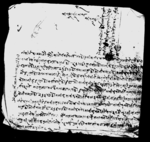A deed of consent submitted by Sumitrānanda Pādhyā to the Guṭhī Bandobasta Aḍḍā promising to furnish a replica of a stolen statue at the Paśupatinātha temple (VS 1970)
ID: K_0501_0032
Edited and
translated by Ramhari Timalsina
in collaboration with
Rabi Acharya
Created: 2021-07-27;
Last modified: 2023-08-29
For the metadata of the document, click here
The accompanying edition, translation/synopsis and/or commentary are available under the terms of the Creative Commons Attribution-ShareAlike 4.0 International License
Abstract
This is a deed of consent submitted to the Guṭhī Administration by Sumitrānanda Pādhyā, deemed responsible for safeguarding a statue at Paśupati that had been stolen, promising to have a replica of it set up within a month.Diplomatic edition
[1r]
1श्री\1श्रीपशूपतिनाथ2१1श्री५सर्कार
2२1य़ोकवुलीय़त्वमोजींकोसालीकसुमी
2त्रानंदलेविधीपुर्वकस्थापनागरेको
3भनीस्हीछापगर्नेजाचकीनारांकृ
4ष्ण¯¯¯ ¯¯¯ ¯¯¯ ¯¯¯ ¯¯¯ ¯¯¯ ¯¯¯ ¯¯¯1१1१६नं1१1सहिसुमित्रानन्दपाध्यान्ह्यौषातोल्[seal][seal][seal]1लीषीतंकाठमाडौन्ह्यौषाटोलबस्नेवर्ष४१कोसुमीत्रानन्दपाध्याआगेभोटुपाडेलेराषेका६७
2सालदेषीसर्कारतालुकभय़ाकागुठीको¯ ¯१¯ कादछीणदर्वाजाकोसालीकहराय़ाकोछभंनेस्मेत्नं
3दप्रसादकोउजुरपरीबुझीय़ामा२दुइपाउकोतामामासुंकोमोलंवाभय़ाकोसालीक१येकचोरी
4भैहराय़ाकोमाठानामाजाहेरस्मेत्गरेकोछुभनीतीमीलेस्मेत्लेषीदीय़ाकोलेतीम्राजीम्मा
5कोसालीकहराय़ाकोभर्नानगरेकोहुंदासोसालीकतीमीबाटभर्नागराउनेस्मेत्गरी७०सालमा
6र्ग१२गतेमाय़स्अडाबाटफैसलाभय़ाकोहुनालेसोवमोजींसावीकवमोजींतामामासुंको
7मोलंव़ाभय़ाको२दुइपाउकोसालीकसावीक्वमोजींवनाइ१मैह्नाभीत्रजडांगरीतय़ारगरुला
8भंनेकवुलीय़तगरीदेउभनीय़स्अडाबाटसोधनीपक्राउभय़ामाचीत्तबुझ्योसावीक्वमोजींतामा
9मासुंकोमोलंवाभय़ाको२दुइपाउकोसालीक१येकसावीकवमोजींबनाइ१मैन्हाभीत्रतय़ा
10रगरुलालेषीय़ावमोजींनभय़ाअै सव़ालषडाभय़ाकाफैसलावमोजींगर्नभनीमेरामनोमा
11नषुसीराजीसंगकवुलीय़तलेषी¯ ¯२¯तर्फगुठीवंदोवस्तमाचढाञ्याइतीसम्वत्१९७०
12सालमार्ग२३गते२शुभ्म्¯¯¯ ¯¯¯ ¯¯¯ ¯¯¯ ¯¯¯ ¯¯¯ ¯¯¯ ¯¯¯
Translation
[1r]
Srī Paśupatinātha 1
The examiner Nārāṃkṛṣṇa, who will attest that Sumitrānaṃḍa has put [back] in place the statute according to the proper procedure in conformity with this deed of consent
1
16 no.
11
Signature of Sumitrānanda Pādhyā, [a resident of] Nhyaukhā ṭola
Written by Sumitrānanda Pādhyā, aged 41, [a resident of] Nhyaukhā ṭola.
Āge. “It has been made known [to the Guṭhī Bandobasta Aḍḍā]] through a complaint from Naṃdaprasāda that a statue set up at the southern gate of the -1- (Paśupatinātha [temple]) has gone missing, having been in the possession of a guṭhī established by Bhoṭu Pāḍe2 , which guṭhī came under the authority of the government in [VS era] year [19]67. From the complaint, it is known that a gilded copper statue3 weighing 2 pāus has gone missing, having been stolen. You (i.e. Sumitrānanda Pādhyā), too, have written that you notified the [concerned] police post [about the matter], and that therefore, since you have not replaced the statue that was under your responsibility, this office (i.e. the Guṭhī Bandobasta Aḍḍā) on the 12th day of the month of Mārga in the [VS era] year [19]70 decided that you need to have the statue replaced.”
Wherefore, I (i.e. Sumitrānanda Pādhyā) have agreed, after this office (i.e. Guṭhī Bandobasta Aḍḍā) detained me for questioning and told me to [do so], to write a deed of consent (kabuliyata), mentioning that, as customary [under such circumstances], I will make a statue that, as customary, is identical with the earlier one, a gilded copper statue weighing 2 pāus, and fit it out within one month. I have submitted this deed of consent to the Guṭhī Bandobasta Aḍḍā of -2- (i.e., Śrī 5 Sarkāra), having freely and willingly written that I will act in accordance with any decision based on the Ain and savālas if what I have written—that I will make a statue that, as customary, is identical with the earlier one, a gilded copper statue weighing 2 pāus, and will have it ready within a month—does not come to pass.
Monday, the 23rd day of Mārga of [Vikrama] era year 1970 (1913 CE). Auspiciousness.

